Product of vectors is the multiplication of vectors but this is not a common multiplication of scalar values or numbers as you also need to consider the direction of vectors.
There are two types of product of vectors which are scalar product also called dot product and vector product also called cross product, and we discuss them below
We call scalar product and vector product but it may be even more easier to call them dot product and cross product respectively considering how they are represented.
What is scalar product of vectors?
Consider any two vectors \(\vec{A}\) and \(\vec{B}\) as shown in Figure 1. Let the angle between the vectors be \(\theta\). We first define the scalar product in mathematical form and give interpretation later.
The scalar product of \(\vec{A}\) and \(\vec{B}\) is written as \(\vec{A}\cdot \vec{B}\) also called dot product of vectors and it is defined as \(\vec{A}\cdot \vec{B}=AB\cos \theta \).
We use dot symbol between vectors for scalar product. The result of scalar or dot product is always a scalar quantity. It means \(AB\cos \theta \) is a scalar quantity not a vector quantity.
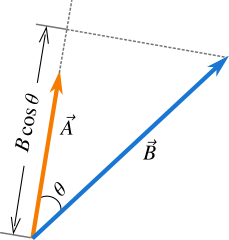
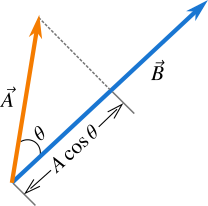
We know that \(A(B\cos \theta )\) is the same as \(B(A\cos \theta )\), and \(B\cos \theta \) is the component of vector \(\vec{B}\) in the direction of \(\vec{A}\) and \(A\cos \theta \) is the component of vector \(\vec{A}\) in the direction of \(\vec{B}\). The interpretation of the scalar product is more clearly shown in Figure 1 and Figure 2.
Now we find the scalar product of unit vectors along x, y and z-axis. Note that the angle between any two unit vectors such as \(\hat{i}\) and \(\hat{j}\) or \(\hat{j}\) and \(\hat{k}\) or \(\hat{k}\) and \(\hat{i}\) is \({{90}^{\circ }}\), therefore,
\[\begin{align*} & \hat{i}\cdot \hat{j}=\hat{j}\cdot \hat{i}=\left| \hat{i} \right|\left| \hat{j} \right|\cos 90=0 \\ & \hat{j}\cdot \hat{k}=\hat{k}\cdot \hat{j}=\left| \hat{j} \right|\left| \hat{k} \right|\cos 90=0 \\ & \hat{k}\cdot \hat{i}=\hat{i}\cdot \hat{k}=\left| \hat{k} \right|\left| \hat{i} \right|\cos 90=0 \\ & \hat{i}\cdot \hat{i}=\left| \hat{i} \right|\left| \hat{i} \right|\cos 0=1 \\ & \hat{j}\cdot \hat{j}=\left| \hat{j} \right|\left| \hat{j} \right|\cos 0=1 \\ & \hat{k}\cdot \hat{k}=\left| \hat{k} \right|\left| \hat{k} \right|\cos 0=1 \\ \end{align*}\]
Now let \(\vec{A}={{A}_{x}}\hat{i}+{{A}_{y}}\hat{j}+{{A}_{z}}\hat{k}\) and \(\vec{B}={{B}_{x}}\hat{i}+{{B}_{y}}\hat{j}+{{B}_{z}}\hat{k}\) and the dot product of these two vectors can be obtained as below. Note here the vectors \(\vec{A}\) and \(\vec{B}\) are written in terms of their components and unit vectors.
\[\begin{align*} \vec{A}\cdot \vec{B} &=({{A}_{x}}\hat{i}+{{A}_{y}}\hat{j}+{{A}_{z}}\hat{k})\cdot ({{B}_{x}}\hat{i}+{{B}_{y}}\hat{j}+{{B}_{z}}\hat{k}) \\ & =({{A}_{x}}{{B}_{x}})\hat{i}\cdot \hat{i}+({{A}_{x}}{{B}_{y}})\hat{i}\cdot \hat{j}+({{A}_{x}}{{B}_{z}})\hat{i}\cdot \hat{k} \\ & \text{ }\text{ }\text{ }+({{A}_{y}}{{B}_{x}})\hat{j}\cdot \hat{i}+({{A}_{y}}{{B}_{y}})\hat{j}\cdot \hat{j}+({{A}_{y}}{{B}_{z}})\hat{j}\cdot \hat{k} \\ & \text{ }\text{ }\text{ }+({{A}_{z}}{{B}_{x}})\hat{k}\cdot \hat{i}+({{A}_{z}}{{B}_{y}})\hat{k}\cdot \hat{j}+({{A}_{z}}{{B}_{z}})\hat{k}\cdot \hat{k} \\ & ={{A}_{x}}{{B}_{x}}+0+0+0+{{A}_{y}}{{B}_{y}}+0+0+0+{{A}_{z}}{{B}_{z}} \\ & ={{A}_{x}}{{B}_{x}}+{{A}_{y}}{{B}_{y}}+{{A}_{z}}{{B}_{z}} \tag{1} \label{1} \end{align*}\]
You have found here that \(\vec{A}\cdot \vec{B}={{A}_{x}}{{B}_{x}}+{{A}_{y}}{{B}_{y}}+{{A}_{z}}{{B}_{z}}\) and we also know \(\vec{A}\cdot \vec{B}=AB\cos \theta \) so the angle between the two vectors \(\theta\) is,
\[\theta =\arccos \frac{{{A}_{x}}{{B}_{x}}+{{A}_{y}}{{B}_{y}}+{{A}_{z}}{{B}_{z}}}{AB} \tag{2} \label{2}\]
What is vector product of vectors?
Vector product is another of kind of product of vectors where the result is again another vector quantity. We define the vector product mathematically and after that we give the interpretation.
First consider two vectors such as \(\vec{A}\) and \(\vec{B}\) and the angle between them is \(\theta\). The vector product of these vectors is defined to be \(\vec{A}\times \vec{B}=AB\sin \theta \hat{n}\).
Note that cross (\(\times \)) sign is used between the vectors to represent that it is a vector product, so we also call it cross product of vectors. In vector product or cross product the result is another vector and \(\hat{n}\) gives the direction of the cross product which is perpendicular to the plane containing the two vectors (see in Figure 3).
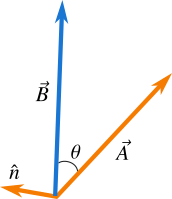
The direction of cross product is identified by a rule known as right hand thumb rule. To identify the direction of \(\vec{A}\times \vec{B}\) we consider that \(\vec{A}\) is moving into \(\vec{B}\) as in Figure 4, in this case towards counter-clockwise direction and curl the fingers of right hand in the same direction leaving the thumb straight up and the thumb gives the direction of \(\vec{A}\times \vec{B}\).
In the same way to identify the direction of \(\vec{B}\times \vec{A}\) we consider that \(\vec{B}\) is moving into \(\vec{A}\) as in Figure 5, in this case towards clockwise direction and we curl our fingers in the same direction leaving the thumb straight up again and the thumb gives the direction of \(\vec{B}\times \vec{A}\).
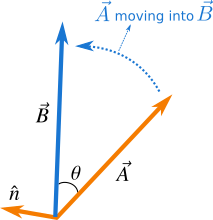
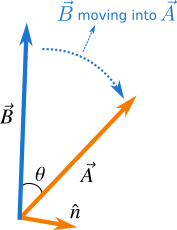
In each case in Figure 4 and Figure 5 the unit vector \(\hat{n}\) gives the direction of the cross product. The discussion above clears that the cross product is not commutative, that is \(\vec{A}\times \vec{B}\ne \vec{B}\times \vec{A}\) as you also need to include the direction; it means the direction of \(\vec{A}\times \vec{B}\) is not equal to the direction of \(\vec{B}\times \vec{A}\).
You know the magnitude of the cross product is \(AB\sin \theta \) and \(A(B\sin \theta )=B(A\sin \theta )\). Note that \(B\sin \theta \) is the component of \(\vec{B}\) perpendicular to the direction of \(\vec{A}\) as shown by Figure 6 and \(A\sin \theta \) is the component of \(\vec{A}\) perpendicular to the direction of \(\vec{B}\) shown in Figure 7. Notice that the magnitude \(A(B\sin \theta )\) or \(B(A\sin \theta )\) is representing the area made by the sides \(A\) and \(B\sin \theta \) or B and \(A\sin \theta \).
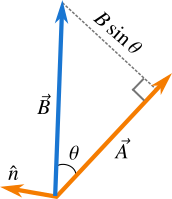
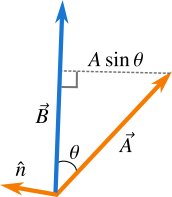
Note that the magnitude is the same for both \(\vec{B}\times \vec{A}\) and \(\vec{A}\times \vec{B}\) but the directions are different. It is good to remind you that equal vectors always have the same magnitude and the same direction. If only the magnitudes are equal they aren't equal vectors; the directions should also be the same.





